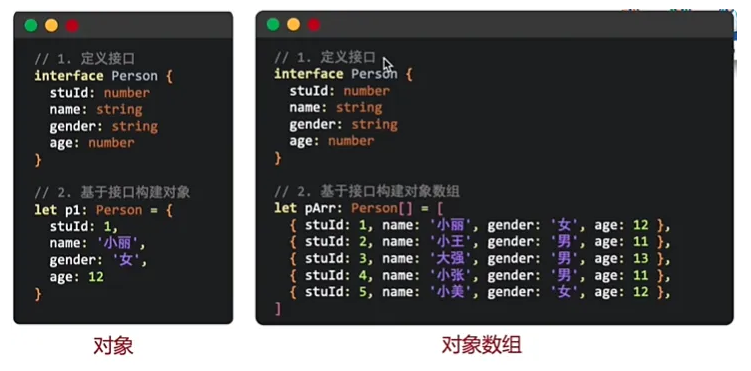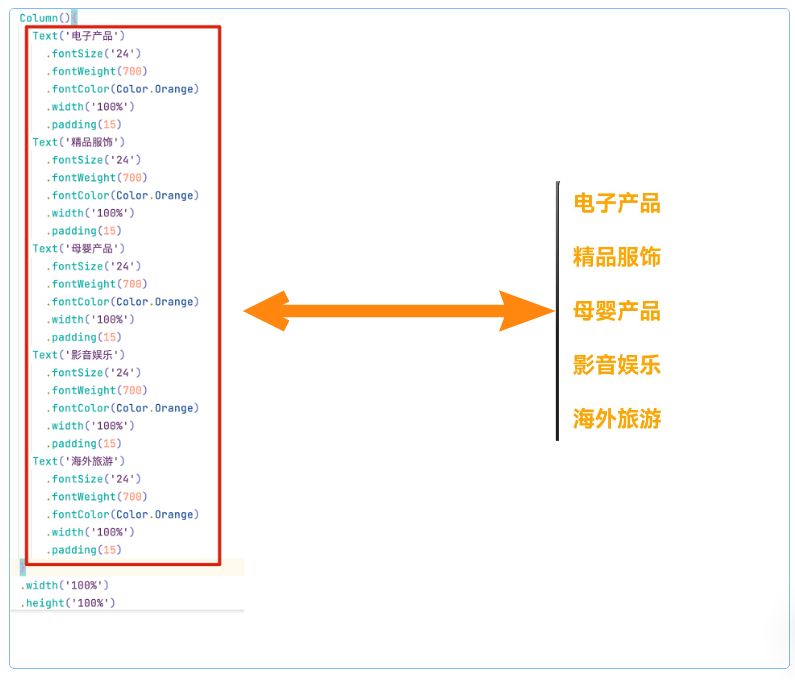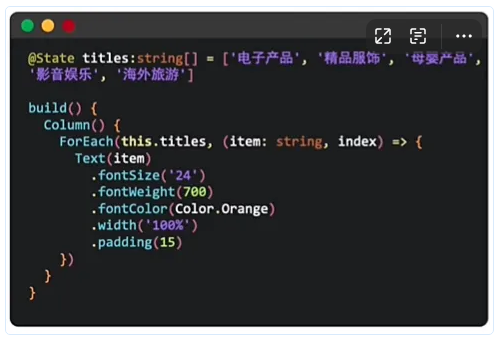回复
八、ArkTS-语句-类型进阶与渲染控制 原创
亚鲁鲁666
发布于 2024-12-10 21:41
浏览
0收藏
1.对象数组
1.1定义对象数组
它是一个自定义对象类型的数组,数组元素是自己定义对象类型的对象,就是数组元素是对象,数组类型是自定义对象的类型

//第一步通过接口定义对象
interface student{
stuID:number,
name:string,
gender:string,
age:number
}
//基于接口创建对象数组
let stuShuZu:student[]=[
{stuID:1,name:'小明',gender:'高三',age:17},
{stuID:1,name:'大明',gender:'高三',age:19},
{stuID:1,name:'二明',gender:'高三',age:18},
{stuID:1,name:'天明',gender:'高三',age:17}
]
//这是一个对象数组类型
stuShuZu
//这是一个对象类型
stuShuZu[0]
//需求:获取每一个学生的年龄,
//看到数组每一个XXX,就要想到遍历
for (let item of stuShuZu){
console.log('学生的姓名是',item.name)
}
@Entry
@Component
struct Index {
//组件的状态变量
@State count:number=1
build() {
Column(){
}
.width('100%')
.height('100%')
.backgroundColor('#eee')
.padding({top:15,right:15,left:15})
}
}1.2使用对象数组
- 访问某一个对象:
- **每一对象在数组中都是有对应的下标的, 可以通过 ****数组名[下标] ****访问 **
- 访问某一对象的某一个属性
- 先找到要访问的对象, 在该对象的属性访问属性 数组名[下标].属性名 访问
- 依次访问每一个对象
- for ... of 进行访问即可
//第一步通过接口定义对象
interface student{
stuID:number,
name:string,
gender:string,
age:number
}
//基于接口创建数组对象
let stuShuZu:student[]=[
{stuID:1,name:'小明',gender:'高三',age:17},
{stuID:1,name:'大明',gender:'高三',age:19},
{stuID:1,name:'二明',gender:'高三',age:18},
{stuID:1,name:'天明',gender:'高三',age:17}
]
//使用数组, 因为数组对象不能直接在日志中显示, 想要在日志中显示需要调用方法转成字符串
console.log('打印数组对象',stuShuZu)
//包含对象的复杂数据, 如果想在日志中打印, 需要需要调用一个方法, 转成字符串
//JSON.stringify(复杂类型)对象/数值
console.log('打印数组对象',JSON.stringify(stuShuZu))
//具体使用(访问->数组下标)
console.log('数组中第二位是',stuShuZu[1].name)
console.log('数组中第二位的信息',stuShuZu[1])//没有调用方法, 打印出来是Object
console.log('数组中第二位的信息',JSON.stringify(stuShuZu[1]))
//也支持遍历, for...of和普通for
for(let item of stuShuZu){
console.log('数组对象中的每一项',JSON.stringify(item))
}
@Entry
@Component
struct Index {
//组件的状态变量
@State count:number=1
build() {
Column(){
}
.width('100%')
.height('100%')
.backgroundColor('#eee')
.padding({top:15,right:15,left:15})
}
}2.ForEach - 渲染控制
当我们页面中的区域中有多个样式相同的小区域,只有内容数据不一样的时候, 为了提升代码的复用率,不需要一个一个的编写UI组件,我们可以将所有的数据整合成一个数组, 并采取ForEach进行循环渲染.如下图区域,如果我们分别实现每个栏目,代码太过于冗余,这时就可以使用ForEach进行渲染了
2.1ForEach语法
可以**基于****数组元素**的个数, 来渲染组件的个数(简化代码),根据数组长度循环渲染组件个数
语法:** ForEach(arr, (item, index)=>{这里写循环渲染的内容})**
arr: 要渲染的数组,
(item, index): (item: 是每一项+类型, index: 是下标) -> 是形参

参数 | 参数类型 | 参数说明 |
arr | Array | 数据源, 根据该数组生成对应的UI组件渲染到页面中: + 可以为空数组 |
UI组件生成函数 | (item: any, index?: number) => void | UI组件生成函数 + 为数组中的每个元素创建对应的组件 + item: 代表每一个数组元素, 类型与数组元素保持一致,不可以省略 + index: 代表每一个数组元素的下标,可以省略 |
@Entry
@Component
struct Index {
//用装饰器定义了一个数组
@State stu:string[]=['大明','二明','小明','天命','耳顺','随心所欲']
build() {
Column(){
//ForEach渲染控制,
//item是形参,可以自己定义写法
// ()=>{} 第一个 参数1 - 永远都是表示数组每一项
// 第二个 参数2 - 永远都是数组下标 - 不取决于命名,只取决于位置
ForEach(this.stu,(item:string,index)=>{
Text(`${item},${index+1}`)
.fontColor(Color.Green)
.fontSize(20)
.fontWeight(500)
.padding(10)
})
}
.width('100%')
.height('100%')
.backgroundColor('#eee')
.padding({top:15,right:15,left:15})
}
}
//接口要定义到程序入口@Entry外
interface news{
title:string,
createTime:string,
}
@Entry
@Component
struct Index {
@State articles: news[]=[
{title:'近200+自动驾驶数据集全面调研!一览如何数据闭环全流程', createTime:'2024-01-31 09-59:43'},
{title:'近200+自动驾驶数据集全面调研!一览如何数据闭环全流程', createTime:'2024-01-31 09-59:43'},
{title:'近200+自动驾驶数据集全面调研!一览如何数据闭环全流程', createTime:'2024-01-31 09-59:43'},
{title:'近200+自动驾驶数据集全面调研!一览如何数据闭环全流程', createTime:'2024-01-31 09-59:43'},
]
build() {
Column(){
//ForEach渲染控制,
ForEach(this.articles,(item:news,index)=>{
Column(){
Text(`${item.title}`)
.fontColor('#000')
.fontWeight(500)
.padding(10)
.width('100%')
Text(`${item.createTime}`)
.fontColor('#999')
.fontSize(14)
.fontWeight(500)
.padding(10)
.width('100%')
}
})
}
.width('100%')
.height('100%')
.backgroundColor('#eee')
.padding({top:15,right:15,left:15})
}
}2.2ForEach使用优化代码
原始代码
完整代码
3.Math对象
Math 是一个内置对象,它拥有一些数学常数属性和数学函数方法, Math 用于 Number 类型数据的处理.
对象方法 | 是否需要参数 | 方法描述 |
Math.random() | 否 | + 随机数 + 取值范围 [0, 1)之间的随机小数,左闭右开, 可以取到0,但是取不到1 |
Math.ceil() | 是 | + 需要一个数字形参数 + 总是向上取整 |
Math.floor() | 是 | + 需要一个数字形参数 + 总是向下取整 |
- 代码测试
// 1. 随机数
console.log('Math对象', Math.random()) // 0-1 之间的随机小数
// 2. 向上取整
console.log('Math对象', Math.ceil(1.1)) // 2
console.log('Math对象', Math.ceil(1.9)) // 2
// 3. 向下取整
console.log('Math对象', Math.floor(1.1)) // 1
console.log('Math对象', Math.floor(1.9)) // 1- 求0--10之间的随机整数
// 0-10 之间的随机数
console.log('Math对象', Math.random() * 11)
// 0-10 之间的随机 整数
console.log('Math对象', Math.floor(Math.random() * 11))- 求n--m之间的随机数
//计算n-m的随机数
let n:number=1
let m:number=10
console.log('n-m的随机数',Math.floor(Math.random()*(m-n+1))+1);
//这种写法0是取不到的, 或者取到0的概率极小
console.log('随机数',Math.ceil(Math.random()*2));©著作权归作者所有,如需转载,请注明出处,否则将追究法律责任
标签
已于2024-12-12 23:02:03修改
赞
收藏
回复
相关推荐




















